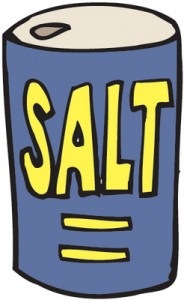 The short answer: no – even though sea salt might be marketed as a health food.
The short answer: no – even though sea salt might be marketed as a health food.
Sodium chloride is the chemical name for salt. Even though the words “salt” and “sodium” aren’t exactly the same they are often used interchangeably. You might find the word “sodium” on the Nutrition Facts Panel on the back or side of a package but yet see a phrase like “low salt” used on the front of the package.
Chemically, table salt and sea salt are not much different although they might taste different or have different textures. Sea salt and table salt, by weight, have the same amount of sodium. They both can have an effect on your blood pressure.
Sea water is evaporated to make sea salt. There is little processing and the water source, along with the trace minerals and elements left behind after evaporation, add flavor and color. Sea salt comes in different degrees of coarseness and types of grain or flake.
Table salt, mined from underground salt deposits, goes through processing to eliminate minerals. It usually has an additive to prevent clumping and may have added iodine, which sea salt doesn’t have.
When you read the labels on sea salt and table salt, they can lead to a bit of confusion. Because sea salt crystals are larger than table salt crystals less sea salt will fit on a teaspoon so the sea salt may seem to have less sodium. However, by weight it does not. But, by teaspoon, table salt has 590 mg of sodium in a teaspoon which weighs in at 1.5 grams. Sea salt has 400 mg in a teaspoon but that teaspoon of sea salt weighs in at 1 gram.
Should You Limit The Amount Of Salt You Eat?
The recommendation for daily sodium intake is a maximum of 2300 mg and not more than 1500 mg a day for people 51 or older, if you’re African American, or if you have diabetes, chronic kidney disease, or high blood pressure. Don’t be fooled by the salt shaker. Adding salt to food is certainly a source of dietary sodium, but processed and prepared foods account for the greatest amount of sodium in American diets.

This is inaccurate information. Processed table salt has a very negative effect on the heart and blood system while sea salt actually improves heart health and cardiovascular function with it’s bio-available minerals. Mother nature gives us food that nourishes… when we process it to pieces it loses it’s value and may even hurt us.
Thank you for your comment. However, the information is not inaccurate. All salt comes from the same source: sea water. The iodine added to table salt (although it is possible to buy table salt without iodine) stems back to the 1900’s when it was added to help treat goiter that was a result of iodine deficiency. This is still an issue in some parts of the world.
According to the Mayo Clinic, “Sea salt and table salt have the same basic nutritional value, despite the fact that sea salt is often marketed as a more natural and healthy alternative. The real differences between sea salt and table salt are in their taste, texture and processing, not their chemical makeup.”
Thank you for your response Penny. I should have been more clear, yes they both contain sodium chloride. However, to call them similar products is inaccurate. Sea salt contains about 84% sodium chloride with about 12% charged minerals (a great mineral source for us). Whereas processed/refined salt contains about 97% sodium chloride and 3% chemicals from processing and some iodine. That makes these two very different. You can not just compare the sodium chloride it’s the mineral content vs. toxic chemicals that make one a health food and the other a health concern.
As a side note, in my research as a nutritionist, I have found The Mayo Clinic to be an unreliable source for consistently accurate nutrition information.
I am not looking to be right… just truthful.
I’m enjoying our conversation, Sarah, because I believe we both want to be truthful. I still have to disagree with you, however. I’ve done some further research — the actual sodium content in salt — both table and sea salt — is around 40% — the rest is chloride with trace minerals (sea salt) or an anti-clumping agent with or without iodine (minerals removed) for table salt. According to http://www.mass.gov/eohhs/consumer/wellness/disease-prevention/heart-disease-stroke/sodiumsalt.html : “Table salt, sea salt, and kosher salt have the same amount of sodium. This means that one kind is not healthier than the others.” I’ve checked numerous other sources as well. I truly appreciate your thoughts and comments.